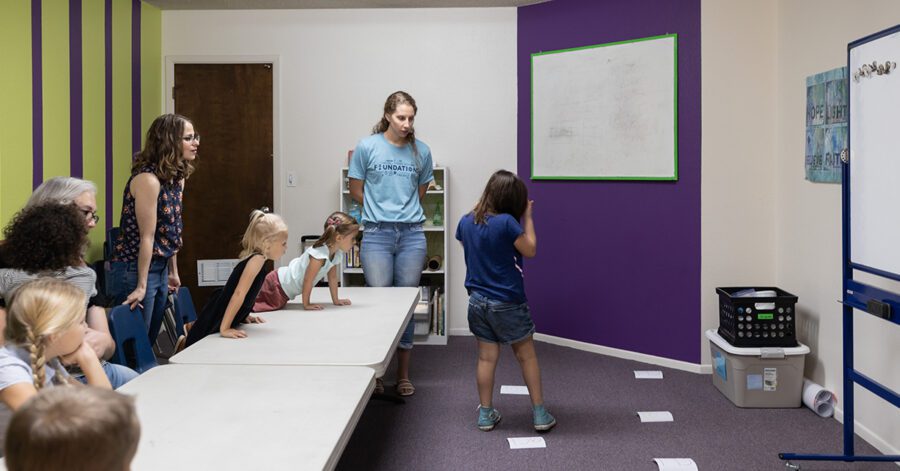A skilled tailor doesn’t discard a beautiful garment simply because it doesn’t fit perfectly off the rack. Instead, they make thoughtful adjustments to suit the individual wearing it. In much the same way, tailoring homeschool lessons allows parents to thoughtfully adjust a well-formed curriculum to fit the unique mind and soul of their student without compromising its beauty or purpose.
Many homeschool parents—especially those guiding their students through the Challenge years—struggle to balance following the guide with the realities of their child’s learning pace and needs. At Classical Conversations, we believe parents are the best equipped to discern how to make those adjustments with wisdom and love.
This article will help you explore how tailoring homeschool curriculum can lead to greater joy, confidence, and growth while still pursuing truth, goodness, and beauty.
Tailoring a Garment
In brief, when a garment is sent to a tailor, it is to adjust an article of clothing by taking it in or letting it out to fit a particular person. The garment, such as a wedding dress, is already beautiful as displayed on the hanger or on the mannequin, but how many people are shaped exactly like a mannequin? Not too many—hence the fact that tailoring a wedding dress is as common as purchasing one.
Because no two human bodies are the same, a tailor must be present to measure the client and later to fit the garment to ensure that the finished product is appropriate for that particular person. A bride does not send her sister to get fitted for her own wedding dress; she must be there in person so the dress ends up fitting her instead of someone else.
Tailoring an Education: Customizing Homeschool Curriculum
The tailoring metaphor relates clothing to homeschool education by illustrating how a formal education can be adjusted to fit a particular child. Like individual bodies have unique characteristics, individual minds and souls have distinctive characteristics.
As surely as a beautiful dress is not made any less beautiful by taking it in or letting it out, a beautiful syllabus is not made ugly, or worse, by tailoring it to meet the needs of a particular student.
Does this mean that there is therefore no use for a syllabus? Of course not. When considering a dress, it is generally designed to fit a human being. For example, even a non-tailored wedding gown is designed to fit a woman—not a tree, or a chair, or a chimpanzee. All women have a bust, a waist, and hips.
In the same way, a good curriculum is designed to fit a human person, not an animal or a machine. The curriculum and the syllabus are general patterns for the human student as much as a bridal gown’s pattern is for a human woman. And like a dress, the course requirements from a particular syllabus must be taken in or let out accordingly.
Read How to Customize Your Homeschool Education
What Tailoring Is Not: Homeschool Lessons Without Compromised Standards
Recognizing that the Challenge guide does not fit—whether quantitatively or qualitatively— every need of your particular student is not the same thing as conforming an education to the whims and desires of your child. A classical and Christian education is founded on the principle that a proper, human education should conform its students to a standard outside of themselves.
Both teacher and student are under an ideal greater than themselves. As C. S. Lewis put it in The Abolition of Man, teachers in older systems “handed on what they had received: they initiated the young neophyte into the mystery of humanity which over-arched him and them alike. It was but old birds teaching young birds to fly.” The ultimate goals of wisdom, virtue, goodness, truth, and beauty are non-negotiable.
Balancing Rigor and Flexibility
If, for example, your Challenge A student routinely spends two to three hours per day on his Latin studies, and this concerns or frustrates you, there is a difference between the decision to tailor the number of exercises he performs per day and the decision to cut Latin out of his routine altogether.
In this instance, the tailoring is a quantitative tailoring—a little less, or more, to balance the hours in a day. The idea that a parent should remove Latin studies from the curriculum altogether because the student doesn’t like it is not tailoring; it is butchering.
Even in performing a quantitative tailoring, we, as parent-teachers, must be attentive to the quality of the time the student spends in performing the exercises or readings. Is it the complexity of the lessons leading to three hours of Latin per day, or is it the attitude or work ethic of the student? If a student’s lousy attitude results in fewer requirements, the student will learn very quickly how to do less Latin per day.
Practical Tips for Recognizing What Tailoring Is Not
- Check Your Motives.
Are you adjusting to support growth—or just to avoid conflict? - Don’t Confuse Dislike with Difficulty.
A student’s resistance doesn’t mean the subject isn’t worthwhile. - Watch for Attitude-Based Adjustments.
Lowering expectations due to poor behavior teaches the wrong lesson. - Be Careful What You Cut.
Reducing assignments can help; removing whole subjects usually harms. - Evaluate Time Honestly.
Is the workload truly too much—or is focus the real issue? - Keep the Standard in Sight.
Tailoring helps students reach the goal, not escape it.
Read how to Tailor with Academic Integrity
What Tailoring Is: Personalized Learning in Homeschool
Tailoring is always keeping your student, as an individual person, before your eyes. Tailoring is remembering that no author, curriculum provider, tutor, teacher, administrator, senator, or president knows or loves your child like you do. They are not supposed to.
Tailoring is paying attention, not only to the attitudes that bubble to the surface, but also to the circumstances under which those bubbles pop. In what ways are we contributing to our child’s frustrations? Have we set clear expectations? Are those expectations reasonable as well as clear? Are we helping them think through their frustrations? Their doubts? Their fears?
Tailoring is recognizing when the gap between what your child knows and what they need to learn has become the size of the Grand Canyon—when they can no longer step across. They need goals they can accomplish, gaps they can step across. And they need a long series of these gaps from birth to graduation to the adult years beyond. We cannot force ourselves or our kids to leap across the Grand Canyon of knowledge. The step must be one that a human being can make.
Tailoring is not giving up on excellence. Tailoring is loving your neighbor as you love yourself. It is not giving up on your child. Quite to the contrary, tailoring is loving your child as you love yourself.
Practical Tips for Tailoring at Home
- Adjust the Load, Not the Goal.
Lighten assignments when needed, but keep the ultimate objective intact. - Watch Your Child Closely.
Pay attention to how they learn best—when they’re engaged, and when they’re overwhelmed. - Adapt to Current Circumstances.
Illness, family changes, or seasons of stress may call for short-term adjustments. - Break Big Tasks into Smaller Steps.
Help your student succeed by creating manageable bridges across learning gaps. - Set Clear, Reasonable Expectations.
Communicate goals with love and clarity—and revise when wisdom calls for it. - Focus on Formation, Not Just Completion.
Choose adjustments that help shape your child’s character and understanding, not just check a box.
Listen: Stop Blaming the Textbook
Key Takeaways on Tailoring Homeschool Lessons
- Tailoring homeschool lessons means thoughtfully adapting the curriculum to fit your child’s unique learning needs without lowering standards.
- Balance rigorous academics with your child’s pace and circumstances.
- Wise tailoring respects the goals of seeking truth, goodness, and beauty while meeting your students where they are.
- As a parent, your insight is key to customizing homeschool curriculum for your Challenge-level student’s growth.
The Right Fit for Growth
You don’t have to choose between academic excellence and your child’s well-being. With love, wisdom, and a willingness to adjust, you can homeschool your child well—right where they are. Learn how the Challenge programs support both parents and students in growing toward wisdom and virtue.
C.S. Lewis. The Abolition of Man. New York, Harper One, 1944.




